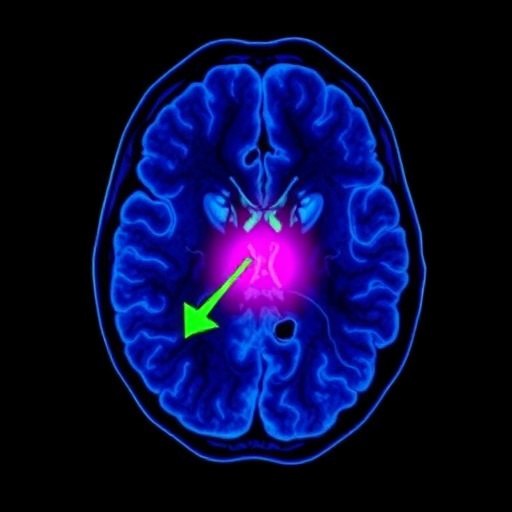In the evolving landscape of genetic research, a recent study sheds light on a crucial discovery that pertains to the ATP5F1A gene’s role in human neurodevelopment. The investigation reported by Xian et al. explores how deficiencies in this gene induce significant developmental delays and motor dysfunction. This intriguing connection has sparked interest in the scientific community due to its implications for understanding developmental disorders across species, particularly in humans and zebrafish.
ATP5F1A, a component of the mitochondrial ATP synthase complex, plays a vital role in cellular energy production. The loss of function in this gene interferes with ATP synthesis, leading to widespread metabolic dysfunctions. Researchers have long suspected that mitochondrial anomalies could threaten the development of the nervous system, and new findings have begun to provide crucial evidence to support this theory. The study conducted uses a cross-species approach, using zebrafish as a model organism to highlight the fundamental aspects of human development affected by ATP5F1A deficiency.
In zebrafish, researchers observed that the absence of functional ATP5F1A results in altered motor behaviors, correlating with observations made in human subjects. The most striking results showcased the motor deficits displayed by the zebrafish lacking the ATP5F1A gene. Such behavioral impairments were tested using various swimming tests, where the deficient zebrafish were notably less coordinated and displayed reduced activity levels compared to their wild-type counterparts. This study underscores the potential of zebrafish models as valuable tools for dissecting the mechanisms behind genetic disorders affecting motor control.
Additionally, the developmental delays associated with ATP5F1A deficiency present critical insights into neurodevelopmental trajectory. The data reveal that zebrafish with ATP5F1A loss exhibited aberrant neuromuscular junction formation. These junctions are crucial for effective communication between the nervous system and muscles; their malfunction can lead to significant physical impairments. This aspect of the research could open up new avenues for understanding not just the mechanisms behind motor dysfunctions, but also the broader implications these might pose for developmental economics in humans.
Comparisons between the fish model and human cases revealed consistent patterns of development delays. In the clinical observations, affected individuals demonstrated significantly delayed milestones ranging from motor skills to cognitive function. The study emphasizes the need for genetic screenings in individuals presenting with unexplained developmental delays or motor issues, as early identification can facilitate timely interventions that could substantially affect quality of life.
Furthermore, the epigenetic implications of the study are monumental. Researchers hypothesize that the absence of ATP5F1A may not only affect immediate development but could cascade into sustained neurodegenerative pathways later in life. The predisposition to similar mitochondrial-related pathologies may set the foundation for a myriad of neurodegenerative disorders, suggesting that early genetic evaluation may be crucial in preventing long-term consequences. Thus, understanding ATP5F1A’s role could pave the way for targeted therapies aimed at correcting mitochondrial dysfunction early in development.
As the scientific community begins to grasp the implications of ATP5F1A deficiency, the next logical step involves further investigations into potential therapeutic interventions. Strategies might include gene therapy to restore ATP5F1A function or compounds that could augment mitochondrial efficiency even in the presence of genetic defects. Nonetheless, the complexity of mitochondrial genetics poses substantial challenges in creating effective therapies, primarily because of the multifaceted nature of mitochondrial biology.
Another promising approach involves pharmacological agents that can enhance mitochondrial biogenesis or stimulate alternative bioenergetic pathways. Recent trials with agents like creatine and coenzyme Q10 have exhibited potential in improving mitochondrial function, thus offering hope for individuals affected by ATP5F1A deficiencies. Continued research into these pharmacotherapeutic avenues could yield profound insights into both preventative measures and treatments for affected individuals.
Furthermore, the influential role of nutrition must not be overlooked. Researchers stress that nutrient intake can substantially affect mitochondrial health. Optimizing diets rich in antioxidants and mitochondrial-supporting nutrients could potentially bolster function, even in those possessing genetic predispositions. Studies exploring the correlation between dietary habits and motor function improvement in patients with ATP5F1A deficiencies will undoubtedly be crucial as researchers aim for holistic approaches to therapeutic strategies.
In summary, the groundbreaking findings by Xian et al. elucidate the alarming effects of ATP5F1A deficiency on neurodevelopment and motor functioning in both humans and zebrafish. Their study signifies a paradigm shift in our understanding of mitochondrial genetics, inviting an urgent call for further research into both preventative measures and therapeutic innovations. The field stands at the threshold of potentially revolutionizing how we approach developmental disorders, leading to more effective diagnosis and treatment strategies that could significantly alter the trajectory of affected individuals.
As research evolves, continuous collaboration between geneticists, neurologists, and clinical practitioners will be essential to translate findings into practice. The knowledge gained from this study not only enriches the scientific literature but also serves as a beacon of hope for families navigating the challenges associated with developmental delays rooted in genetic anomalies. The quest to further comprehend ATP5F1A’s multifaceted role in neurodevelopment marks a significant step in unraveling the complexities of genetic disorders, with the potential for profound implications in public health and medicine.
As we advance in our understanding, the exploration of mitochondrial function’s implications for learning and communication will likely yield fruitful areas for intervention. In time, comprehensive connections between metabolic disorder, genetic expression, and neurobehavioral outcomes will become clearer, guiding researchers and clinicians alike in addressing the urgent need for effective treatments. The findings of this study remain a crucial step towards unraveling the complex web of genetic influences on human development, creating pathways for innovation in both understanding and managing developmental delays.
Subject of Research: Investigation of ATP5F1A deficiency and its effects on developmental delays and motor dysfunction in humans and zebrafish.
Article Title: ATP5F1A deficiency causes developmental delay and motor dysfunction in humans and zebrafish.
Article References:
Xian, C., Luo, Q., Li, W. et al. ATP5F1A deficiency causes developmental delay and motor dysfunction in humans and zebrafish.
J Transl Med 23, 1054 (2025). https://doi.org/10.1186/s12967-025-07032-x
Image Credits: AI Generated
DOI: 10.1186/s12967-025-07032-x
Keywords: ATP5F1A, motor dysfunction, developmental delay, zebrafish model, mitochondrial genetics, neurodevelopment, gene therapy, pharmacological agents, epigenetics, nutrition.




